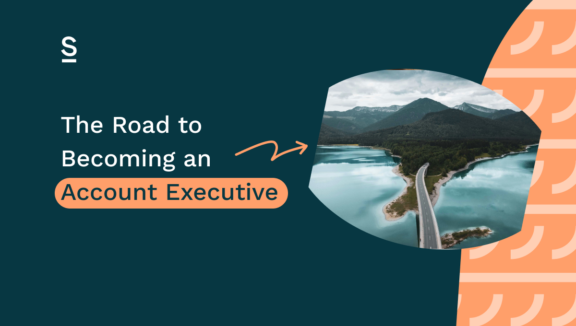The Road to Becoming an Account Executive

“Mum, when I grow up I want to be an Account Executive!”
…said no child ever.
(If that was your childhood goal, sorry. We stand corrected).
That said, now that we’re adults who have to – you know – go to work, pay the bills, hopefully not do something too soul-destroying, an Account Executive (AE) is actually a pretty awesome career choice.
AE’s are usually masters at the craft of selling and product experts. The job often comes with the opportunity to be a real leader within your business, and take your career wherever you want it (stick as an AE and focus on earning? You can do that. More interested in a strategic or Head of Sales role? You can do that also).
Plus, it’s a lot more realistic than being an Astronaut or a TikTok star.
That said, you can’t just walk into an AE position. It’s a competitive role that’s not for everyone – you have to stand out, keep up with emerging trends and continuously go the extra mile to get there.
If you’re wondering what the extra mile actually looks like – you’re in luck. It’s exactly what we’re going to run through in this blog post:
- What is an Account Executive
- Essential skills for an Account Executive
- Educational and professional pathways
- Gaining relevant experience
- How to transition from SDR or BDR to AE
- Showcasing your readiness for promotion
Your new career awaits. Let’s go!
What is an Account Executive ?
First things first, let’s take a quick look at the typical roles within a B2B sales team.
The Account Executive role
The typical AE will work on taking warm leads down the funnel towards close.
They’ll usually have a warm lead passed to them from a BDR or SDR. From there, it’s their responsibility to dig deeper into the prospect’s pain points, demonstrate how the product will work, answer questions and concerns, get buying committee alignment and close the sale.
They usually define their own sales strategies, or work with senior leaders to do so, and should help with the transition from customer to client too.
This process will look different for every business, but it usually follows something like:
- Prospecting undertaken by SDR or BDR
- Intro call taken by SDR or BDR
- Discovery call & product demo taken by AE
- Follow-ups handled by AE
- AE brings sale to a close
BDRs and SDRs: what’s the difference?
Good question! These titles (Business Development Representative and Sales Development Representative, if you want to get formal) can be used interchangeably.
That said, usually:
- BDRs work on inbound leads – that’s leads that have come in as a result of marketing campaigns.
- SDRs focus on outbound – that’s cold calling, LinkedIn prospecting and outbound email campaigns.
Broadly speaking, they work on turning cold leads into warm ones, before passing them to the AE to close. And they’re often (but not always!) more junior members of the team.
Note: these aren’t totally prescriptive: your team might look a little different. For example, in smaller companies AEs often spend some of their time prospecting as well as handling the warm leads, and there may only be either SDRs or BDRs rather than both.
Ok, so we know what an AE does. Next up, how do they do what they do?
Essential skills for an Account Executive
A good Account Executive will work on their hard and soft skills. It’s not enough to be an amazing people person but weak on the technical details – or to have incredible product knowledge but not be that interested in your prospect’s pain points.
Let’s jump into what these look like in practice.
Soft skills
Interpersonal skills: being an AE is a bit like being a spy. They need to uncover the prospect’s true pain points and figure out how to turn these into max-value deals. In practice, this means being able to build relationships, practicing active listening and being empathetic.
Spy skills aside, they’ll also need to be expert negotiators. Getting all the value out of a lead while remaining best friends with them is a tricky balancing act – add tightrope-walking skills to the list too.
Resilience and adaptability: as we said before, being an AE isn’t for everyone. Every single person and business they’ll deal with is different – which makes it impossible for them to do their job on autopilot – and even the best AEs have deals go wrong. For the inexperienced, this can be hard to deal with – particularly if your sales cycles are on the long side.
Chuck the fact that B2B sales changes pretty regularly itself into the mix, and you’ll start to build up a picture of just how resilient and adaptable you have to be as an AE.
Hard skills
Sales techniques: as an AE, you’ll need to have an intricate knowledge of different sales methodologies and know when and where to apply them. You’ll also need to be adept at using a CRM – not just for tracking, but for data mining and analysis, too.
Technical skills: gone are the days when all that stood between you and a sale was a landline telephone. The modern AE has plenty of tools at their disposal – stuff like intent data providers, contact data enrichment tools (ahem), LinkedIn Sales Navigator…and you have to be an expert in all of them.
Data analysis: the best AEs actually spend less time selling, and more time preparing. Digging into historical data from previous sales and first- and third-party intent data, allows them to have more control over the sales cycle.
Organizational skills
Time management: just like Love Islanders, you don’t put all your eggs in one basket as an AE. And that means juggling different deals at different stages, and making sure you know how to prioritize your activities accordingly. There’s no beating around the bush: AEs have very busy days, and you need to be a pro at fitting it all in.
Project management: as the leader of a sale, it’s often down to the AE to coordinate with all the relevant teams, make sure everyone is well-informed, and cross-communicate between the prospect and the business too.
How to become an AE: educational and professional pathways
There’s no single road to becoming an AE – and that’s a good thing! Here are some of the typical routes you might take to get there:
- Formal education: AEs with degrees (hey, that rhymes!) often studied business, marketing, or communications
- Alternative career histories: started your career in customer service, or maybe somewhere else in the same industry? Or maybe you’re in a sales-adjacent role like marketing or customer success? All of these are excellent pathways to becoming an AE, as a lot of the skills overlap
- Certifications and courses: you can take sales-specific courses, or ones that focus on certain skills the role requires – like leadership or management, for example
All of these pathways can be fantastic springboards into an AE role – but they’re not necessary if education’s not your thing, or you haven’t worked in a similar role before.
Gaining relevant experience
Here’s how to work your way up to being an AE:
- Entry-level roles: a position like Sales Representative or Sales Associate can be a great introduction to the world of sales, and give you time to hone the basics before trying something more senior
- On-the-job learning: every day is a learning experience. That sounds pretty cheesy – but it’s cheesy because it’s true. Learn from the AEs you work with and ask them for help and advice where you can. As a junior sales team member, every situation you find yourself in – from your first successful call to your first lead going cold – is prepping you for an AE position.
How to transition from an SDR or BDR to an AE
Some good news: you can move from an SDR or BDR role to an AE role pretty quickly. Anywhere from six months to two years seems to be a good rule of thumb (if it takes you a little longer – don’t sweat it. Far better to come into the role when you’re ready rather than sticking to an arbitrary timeline).
Let’s take a look at all the factors that lead to a promotion:
- Performance: if you’re consistently meeting or exceeding your quotas as an SDR or BDR, it’s pretty obvious that you’re ready for the next step. This isn’t just about being good at your job or having a natural talent for turning cold leads to warm ones, but demonstrating that you have the grit and tenacity to consistently show up and work hard.
- Skills development: nailing the soft and the hard skills we talked about earlier here. It’s often hard to be truly self-reflective when it comes to what we’re good and bad at. Asking for feedback is a good move here – you might find out you need to work on your active listening skills, or you have a tendency to waffle when you talk about the technical implementation of your product.
- Demonstrating initiative: you need to show you’re hungry for the next step. Sniff out additional responsibilities – there’s always going to be something else you can do – and show your leadership potential. This could be anything from giving the more junior members of your team a helping hand, or starting to test and report on new strategies and techniques.
- Building relationships: unfortunately, people aren’t mind-readers. If you keep yourself to yourself it’s unlikely your manager will know you want a promotion. Make it clear where you want to go, and make it as easy as possible for any decision influencers to operate in your favour. That means demonstrating how a promotion would make their lives easier, and being someone they actually want to promote, too.
Showcasing your readiness for promotion
It’s crunch time. You feel you’re ready, and you’re about to go in all guns blazing.
Wait a second!
Make sure you’ve run through these tips first:
Talk to your manager: find out what the promotion process is at your business, and make sure your manager knows it’s what you want so they can do their bit.
Choose the right time to ask: think about how the company’s doing, and where you are in the financial year too. If it’s just had a tough quarter, it might take a little longer to get over the line. Consider timing your ask for around the time budgets are being set too.
Prepare: this means – you guessed it – data. Document your metrics and show how consistently you’re hitting quota. It’s also a good idea to gather qualitative feedback too, from customers and coworkers alike.
Ask for feedback: you should be doing this already, but asking exactly what you need to do to get a promotion is a great motivator – and shows off your continuous learning mindset. If things are going to take a little longer than you’ve hoped, don’t worry about it! Great things take time, and you want to be totally ready for your new role.
Additional resources
Can’t get enough of learning and development? Check out additional resources like:
- Social media: YouTube and LinkedIn are full of sales experts sharing their tips and tricks (hey, we know a good account to start with!)
- Popular B2B brands: sales and marketing tech brands are masters at creating content for people like us (woah, this is getting a bit meta). Go and familiarize yourself with their blogs.
- Books: popular today are titles like Never Split the Difference and The Sales Development Playbook
- Courses: have a hunt on Udemy or Coursera for courses to help you develop specific skills – like time management, project management or active listening
Let’s wrap it up!
The Account Executive role isn’t for everyone – it’s a tough gig that only the very best salespeople really excel at. For the right individual, though, it can be incredibly rewarding.
Ready to put in the effort, become responsible for your own learning, and flex your resilience muscles? You’re already well on the way. See you at the end of the road!

It’s a long and winding road to AE-level
Fortunately, Surfe is here to travel it with you, every step of the way. And we don’t even charge for it.
FAQs about becoming an Account Executive
How to become an Account Executive?
Account Executives usually come into sales through three different pathways: education, an adjacent career, or an entry-level sales position. From there, it’s most likely that Account Executives worked as an SDR or BDR before getting promoted to an Account Executive role. To get this promotion, individuals must demonstrate a mixture of soft and hard skills as well as regularly exceeding their targets and showing they are ready for more responsibility.
How to become an Account Executive with no experience?
It’s unlikely you’ll be able to become an Account Executive straight away with no experience, but it is possible to work your way up to the position. Typical routes include working an sales-adjacent career like marketing or customer success before moving over, or working your way up from an entry-level or SDR/BDR position.
What does an Account Executive do?
An Account Executive is responsible for converting a warm lead into a sale. This means guiding them through the funnel with in-depth discovery calls, product demos, and follow-ups, as well as the administrative organisation that goes into signing a contract. It’s likely that the AE will have to work cross-functionally across the business to successfully close the deal
Is it hard to be an Account Executive?
Being an Account Executive is not for everyone. The role requires you to be resilient and adaptable to change, as well as have a great mixture of soft skills and hard skills like interpersonal skills and technical knowledge.


